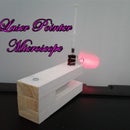Introduction: Jitterbugs! Vibrating Robotic Bugs
Brushbots are the simplest 'robot' you can make. A small vibrating motor, a battery and the bristle end of a tooth brush combine to make a small toy that moves around a flat surface. While they're cheap and easy to build, they lack a little in the control and modification department. I wanted a project that was simple and had a low parts count, but I wanted it to be a little more advanced to engage a wider age group. After a bit of tinkering I came up with the Jitterbug.
The Jitterbug is built on a strip of circuit board. It has a battery holder, an on/off switch and a vibrating motor. It also has eight wire legs and two wire antenna. The wire legs allow for much more control of the bot's behavior. By changing the legs' position and shape it can go forward at various speeds, go in circles or even spin. The antennae can be shaped to help the bot maneuver around obstacles or guide the bot along a raised ridge.
The Jitterbug requires the following parts-
1 adhesive pill style vibrating motor
1 1bit DIP switch
1 CR2032 3v button cell battery
1 CR2035 battery holder
1 5x18 strip of circuit board
25" of bare 18ga copper wire
You'll also need the following tools-
wire cutters/strippers
soldering iron
solder
A helping hand or board clamp makes assembly easier, but it's not necessary.
Many of these parts can be recycled or salvaged from other things. Old cellphones are a great source for vibrator motors. DIP switches can be found on circuit boards and removed with a soldering iron, or just skip the switch and remove the battery to turn it off. Battery holders can be improvised and wire is everywhere! Seriously, I just cut open a 6' piece of telephone transmission cable that was left behind after a phone line repair. There were 200 strands of multi colored solid core 24ga wire- 1,200 feet in all. Once it's all separated it will last me for the next year or so. The difference between trash and supplies is imagination.
Step 1: A Note on Planning the Project
I do STEM and maker related workshops and classes for a living. It's important when I design a project to make it as scaleable as possible. It should be adaptable for a wide range of skills, physical abilities and ages. I've designed the Jitterbug with that in mind.
As I'll present the project here, it's a basic spider shape with eight long legs and two antennae. This configuration has the most 'tweakability'. The legs can be shaped and positioned in a wide variety of ways to make the bot move in different ways and at different speeds. The antennae can be arranged as bumpers, to guide the bot around corners or to follow a groove or raised ridge. If I was working with people who were new to soldering I would use a wider strip of circuit board and have them attach the legs and antennae first as soldering practice before assembling the circuit. I find that it's a bit easier to assemble the circuit without the legs in the way, so for experienced solderers I'd do it that way. If I was doing this project with younger children, I'd go with shorter legs. Kids may lack the dexterity or get bored with the fine tuning needed with the longer legs. Shorter legs are easier to get moving, but lack the control possible with the long-legged design. While adults and teens tend to like a cleaner look, kids love googly eyes, pipe cleaners and pom-poms to decorate the bots. For students with physical limitations the kits could be partially assembled to facilitate their completion.
Step 2: Assembling the Circuit
This is a really simple circuit. The battery connects to the vibrating motor with a switch to interrupt the flow of electricity.
This project requires soldering. If you don't know how don't fret- there are plenty of tutorials here on Instructables to get you started. Be patient and you'll have it down in no time.
First I attached the battery holder. It has a flat side that's higher than the rest of the holder. The solder post on this side is the positive terminal. This side will face towards the board while the curved side is to the outside. I put the holder in place on the circuit board, bent the tabs to hold it in place and clipped it into my helping hand tool.
The vibration motor has 'polarity', meaning that if it is connected backwards it won't work. Use a wire stripper to remove a bit of insulation from the end of the motor's wire leads. Now take a look at the CR2032 battery. One side is smooth with a lip wrapping around the sides and has something like 'Lithium Cell CR2032 3v +' printed on it. This is the battery's positive terminal. The other side is usually textured. This is the ground terminal. Pinch the battery with the red wire on the positive side and the blue wire on the ground terminal. It should vibrate. Switch the wires around so the red goes to ground and the blue goes to positive. Now the motor won't work. Make sure you have the polarity correct before soldering the motor wires in place.
Now look at the battery holder. It has two contacts- one for the flat ground side and another to connect the positive edge of the battery. Determine which battery contact connects to which solder post. Carefully solder the motors blue ground wire to the battery holders ground post. Carefully remove the adhesive backing from the motor and affix it to the circuit board under the battery holder. Leave the red positive wire unattached for now.
Next we'll install the 1 bit DIP switch. arrange it in line with the circuit board flush against the battery holders flat side so that the positive post of the battery is close to one of the switch's posts. Bend the DIP switch's tabs over to hold it on the board and solder the red motor wire to the other switch post. Finally, bend the battery holder's positive post and the switch's free post toward each other and solder them together. The circuit is complete. Install the battery and flip on the switch to test the circuit's function. It should vibrate now. If not retrace your steps, check your solder joints and insure that you have the proper polarity on the motor connections.
Step 3: Attaching the Legs
The legs are made from four pieces of bare 18ga copper wire. These are bent in half with needle nosed pliers, creating a flat section at the bend, like a hair pin. The legs should all be the same length so take special care with this step. I inserted the wire into the edge of the circuit board from the top just forward of the battery holder. I soldered these legs in place and then inserted another pair in front of these. I arranged the legs so they would have one circuit board hole separating each leg. I repeated the process on the other side and the legs were done.
Step 4: Shaping the Legs
The leg shape and position is very important to the bot's behavior. I used the needle nose pliers to bend the legs into an insect like position. I've found that the legs work best with the lower leg section perpendicular to the travel surface and the feet bent backwards slightly. Experiment with various positions until the bot moves the way you want it to. Bend the wire carefully- copper gets stiff if it's bent and reshaped too many times.
Step 5: Adding Antennae
The antennae are made from another 5" piece of the bare wire. They attach to the front of the bot. They can be bent down to guide the bot along a groove or curved out to the front to guide the bot around obstacles. The antennae also act to counter balance the battery and holder.
Step 6: Presenting the Jitterbug
Here's the completed Jitterbug in action-
Jitterbug! from chuck stephens on Vimeo.
Jitterbugs x 2! from chuck stephens on Vimeo.
Note- While playing around with the design I discovered that using 22ga steel wire for the legs made the robots move better. The steel wire is stiffer and transfers the vibration to the surface much better.
So what now? Jitterbugs are great for entertaining cats. They're a great desk toy/time waster. If you build Jitterbugs as a group activity why not have a Jitterlympics? Who's bot can go in the straightest line? Who's faster? Send your bots into a cardboard maze to see who can make it through without getting stuck. Have a sumo match to see who's bot has the most traction to push their opponent out of a circle. Attach a felt tip pen and let your Jitterbug express it's artistic side.
The intent of the Jitterbug project is to let folks play around and see what's possible. Try different leg and antenna shapes and positions. Build several with the motors mounted in different positions to see how it affects the bot's motion. Decorate them!Most important- have fun!








![Tim's Mechanical Spider Leg [LU9685-20CU]](https://content.instructables.com/FFB/5R4I/LVKZ6G6R/FFB5R4ILVKZ6G6R.png?auto=webp&crop=1.2%3A1&frame=1&width=306)




